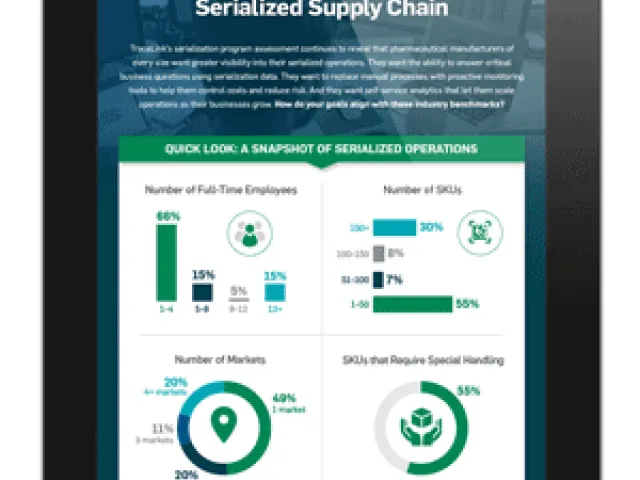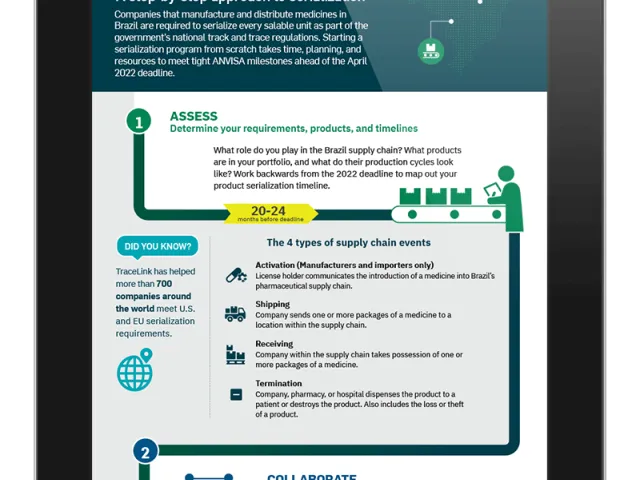Table of contents
Multinational companies that manufacture and distribute medicines in The People’s Republic of China must gear up quickly to meet the country’s latest track and trace regulations and understand the government’s evolving technical guidelines. In a recent article, Are Your Products China Ready? Three Key Decisions for Multinational Pharma Companies, we noted that the broad framework of systems and standards for identifying products and exchanging product data with government regulatory agencies has been established, allowing companies to begin planning their China serialization and packaging configuration strategy.
The next step for companies will be to understand their responsibilities under the law. The 2019 revisions to China’s Drug Administration Law, and the related regulations and technical specifications which have been published since the law’s passage, introduced new terminology into the regulations and guidelines, including many that replace or are equivalent to terms from the original 2015 China serialization and traceability law. This glossary defines key terms, acronyms, and names that companies are likely to encounter as they begin to survey China’s regulatory landscape.
AliHealth
Alibaba Health Information Technology Limited developed and provided the Product Identification, Authentication, and Tracking System (PIATS) which was used as the central government system for the original China product serialization and traceability regulations which were implemented between 2013 and 2015. New laws and government regulations developed between 2017 and 2020 have defined a multi-tiered drug information traceability system which does not rely on a single central system.
China Drug Electronic Administration Code (DEA Code)
A one-dimensional barcode that includes a 20-digit DEA code number applied as a product identifier to meet NMPA product traceability requirements. Also referred to as eCode.
China Food and Drug Administration (CFDA)
Chinese regulatory agency which developed the original drug serialization and traceability regulations. The CFDA has since been reorganized and renamed today as the National Medical Products Agency (NMPA).
China National Drug Code (CNDC)
A 14-digit code—similar to the GS1-standard Global Trade Item Number (GTIN)—developed by the CFDA to identify the manufacturing company, locality, and product type. Replaced by the China Drug Electronic Administration Code.
CSP (See: Drug Traceability Collaborative Service Platform)
DAL (See: Drug Administration Law)
DEA Code (See: China Drug Electronic Administration Code)
Drug Administration Law (DAL)
The Drug Administration Law was passed on August 26, 2019 and came into force on December 1, 2019. It represented a major systematic and structural change to China’s overall drug administration framework governing drug research, registration, production, distribution, and other activities. This law set the legal foundation for the development of specific regulations across these areas but did not provide specific implementation dates for any of its requirements. Some of the objectives of the amended law include:
- The establishment of a drug traceability system based on NMPA drug traceability standards and specifications and designed to ensure that all information generated in drug research, manufacturing, distribution, and usage is true, accurate, and traceable.
- Ensuring the country’s drug supply through a monitoring system
- Establishing a pharmacovigilance system for drugs distributed in China
- Enhancing the existing drug registration system
- Increasing specific penalties for non-compliance
Drug Traceability Code (DTC)
A general term used to describe the traceability code applied to a pharmaceutical product using either the EDMC or the ISO/IEC 15459 product serialization and encoding standard. It is composed of both a Drug Identification Code and a Production Code. The DTC is not only used to uniquely identify drug products but is also included in several China compliance reports.
Drug Traceability Harmonization Services Platform (HSP) / Collaborative Service Platform (CSP)
In China’s 3-tiered drug traceability infrastructure, the drug traceability service platform serves as a “bridge” between the manufacturer’s traceability solution (or its third party solution) and the government’s regulatory system. Sometimes referred to as a “collaborative service platform,” it provides drug code management and sharing services for enterprise regulatory and traceability systems, and is developed and administered by the NMPA. Under the original 2015 law, there was a single government system for traceability reporting which was developed at the time by AliHealth. The NMPA is responsible for developing the HSP under the new 3-tiered infrastructure.
Drug Traceability Supervision System
The Drug Traceability Supervision System describes a set of government platforms developed by the central China government and individual provinces as part of the three-tier Drug Information Traceability System. The Supervision System provides a broad variety of services and information to the government including summary analysis and information on drug products, their state, and their related transactions across the China drug supply chain, recall management, product supply insights, and early warning services of potential impending issues.
Drug Traceability System
The drug traceability solutions and platforms which are designed to generate/assign unique drug traceability codes to products across multiple packaging levels, and for the collection, storage, and sharing of information about drugs and related traceability information. Drug Traceability Systems are used by supply chain stakeholders (manufacturers, distributors, dispensers) to generate and capture information about drugs moving into and through the supply chain, reporting such information to the NMPA’s Drug Traceability Harmonization Service Platform.
eCode (See: China Drug Electronic Administration Code)
Also referred to as DEA Code or DEA/eCode.
Electronic Drug Monitoring Code (EDMC)
A product identifier that uses a DEA Code to meet NMPA product traceability requirements.
GB/T 1988/1998 Standard
This Chinese standard specifies a character set of 128 characters (control characters and graphic characters, such as letters, numbers, and symbols) and their coded representation. The alphanumeric composition of the Drug Traceability Code includes symbols from the GB/T 1988/1998 Standard.
GS1
GS1 is a not-for-profit organization with headquarters in Belgium that develops and maintains global standards for barcodes that can be scanned electronically. Linear and 2-dimensional GS1 barcodes are the de facto standard for serializing medicines around the world, from individual units to aggregated packs, cases, cartons, and pallets. (See: ISO/IEC 15459)
ISO/IEC 15459
China serialization and encoding standards specify the ISO/IEC 15459 coding format as an alternative to the Chinese DEA/eCode format. Because the GS1 and ISO standards organizations collaborate so closely, GS1 coding and information standards are often based on ISO standards, and the ISO/IEC 15459 format is the functional equivalent to the GS1 components used across the global pharmaceutical supply chain to identify and track medicines and medical products.
| GS1 Component | ISO Equivalent |
|---|---|
| GTIN (Global Trade Item Number) | ISO/IEC 15459-6 |
| SGTIN (Serialised Global Trade Item Number) | ISO/IEC 15459-4 |
| SSCC (Serial Shipping Container Code) | ISO/IEC 15459-1 |
| GIAI (Global Individual Asset Identifier) | ISO/IEC 15459-4 & 5 |
| GRAI (Global Returnable Asset Identifier) | ISO/IEC 15459-5 |
Measures for the Supervision and Administration of Pharmaceutical Production (Order No. 28)
Published on March 30, 2020 and put into force on July 1 as part of the regulatory implementation of the Drug Administration Law, these 81 articles cover a wide range of pharmaceutical activities and are supported by several NMPA articles on the interpretation of NMPA standards and guidelines. Several foundational articles are of particular interest to companies that manufacture and distribute pharmaceutical product in China:
- Article 2 specifies that “the production, supervision and management activities of drugs marketed within the territory of the People's Republic of China shall comply with these Measures.”
- Article 3 notes that companies “engaging in pharmaceutical production activities shall abide by laws, regulations, rules, standards and norms, and ensure that the information of the whole process is true, accurate, complete, and traceable.”
- Article 4 states that “drug marketing license holders and drug manufacturing enterprises shall:
- Establish and implement a drug traceability system
- Grant traceability labels to drug sales and packaging units at all levels in accordance with regulations
- Implement drug traceability through informational methods
- Record and save drug traceability data in a timely and accurate manner, and provide traceability information to the drug traceability collaborative service platform”
Article 4 does not explicitly mention the rest of the stakeholders in the supply chain such as wholesale distributors, retail pharmacies, and dispensers, but this should not be interpreted that the rest of the supply chain does not have traceability requirements. Instead, the Measures were intended to focus primarily on rules and requirements for companies directly involved in pharmaceutical production.
National Medical Products Administration (NMPA)
The National Medical Products Administration (NMPA) (formerly the China Food and Drug Administration, or CFDA) is a ministerial-level agency under the State Council of the People's Republic of China. The NMPA supervises the safety management of food and cosmetics and is the competent authority of drug regulation in mainland China.
Order No. 28
(See: Measures for the Supervision and Administration of Pharmaceutical Production)
TraceLink: A proven partner in China compliance solutions
Staying up to date on the complexity of China’s regulatory requirements is a significant challenge—even for companies with experience in other global markets. Since 2013, TraceLink has been helping companies meet the original China serialization and traceability regulations with our China Compliance reporting and related serialization solutions. In addition, TraceLink has been a noted partner for companies in helping them understand the legal, regulatory, operational, and technical requirements for China through the TraceLink Community and our China Special Interest Group of operational leaders, regulatory experts, and technical innovators.
Learn more about joining TraceLink’s Community and our track and trace solutions for China.









